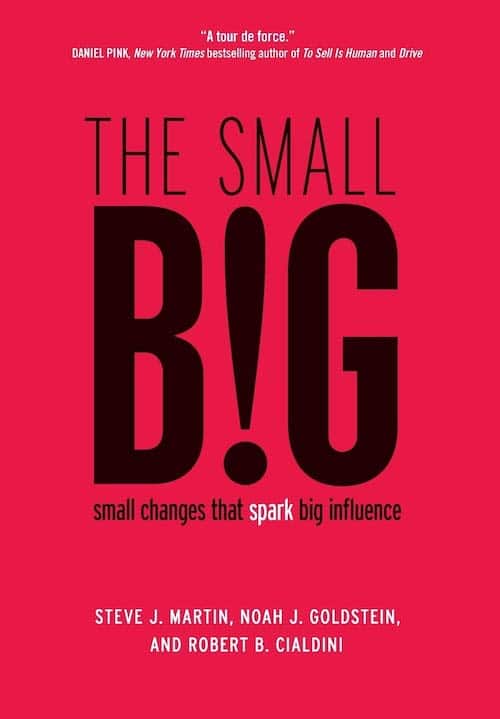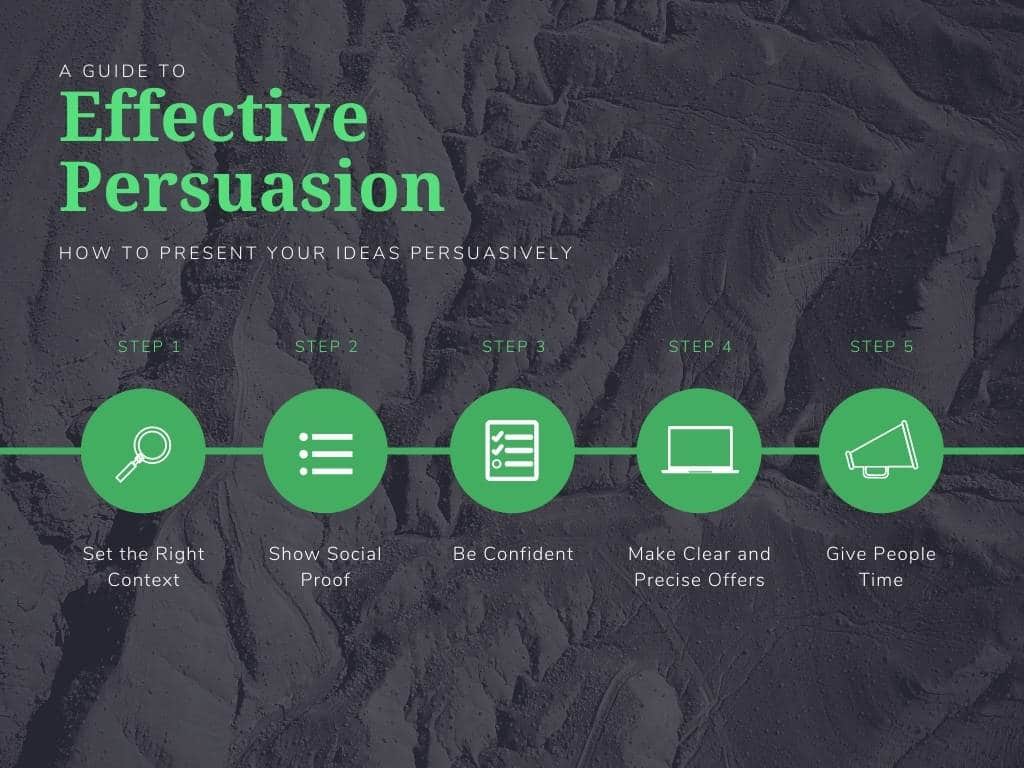Negotiation and persuasion are part of our lives, whether it is as a parent negotiating with a child, or negotiations with a prospective client. Winning the opposite person over doesn’t require more than exercising persuasion tactics that one can easily learn to make a big difference.
The Small Big by Steve J Martin, Noah J Goldstein, and Robert B Cialdini, gives us small changes to incorporate in our behaviors for more confidence and success.
Persuasion Can Impact Commitment
Persuasion is very important. A small change in persuasive tactics can hugely change behaviours for the better.
A lack of persuasion can have expensive consequences, especially when we lose a lot of revenue as a society. For example, in the health care industry DNA, meaning ‘Did Not Attend’ refers to all the patients who have an appointment but do not show up. DNA issues amount to about 800 million pounds of revenue loss in the UK itself. Simply persuading patients to show up for appointments can save the economy a lot of revenue loss.
Similarly, late, or absent payments are the reason heavy charges are paid by governments, companies, and consumers alike. Even slight persuasion in the form of detailed information can help change the approach of people.
Another example is persuading employees in an organization to switch off the light that is not needed. This can impact electrical costs for a company and help the environment at the same time.
Unfortunately, as simple as these rational measures seem, they fail. However, the science of persuasion believes that a small change in how people are persuaded to follow these simple rules can lead to a big change for the better.
Therefore, to get employees to remember to switch lights off, a garbage bin can be placed below the lights. This will predispose employees to switch off the lights at the end of the day as they empty the bins.
The idea is to change the way people perceive their commitments and how they go about acting on them.

How Changing Environment Can Change Behaviour
The environment that exists during any negotiation or persuasion makes a big difference to the success of the persuasion. Environments can also affect how responsible a person is depending on the situation.
An experiment conducted by Keizer of placing advertisements on the bikes of customers in front of a shopping mall showed how people’s behaviors changed depending on the surrounding environment.
When graffiti was present on the walls of the adjacent alleyway, about 69% of the people threw the pamphlets on the floor. When there was no graffiti, only 33 % threw the pamphlets on the floor and littered the space.
Another experiment showed that seating arrangements during a group discussion changed the results of the discussion. They found that discussions that focused on what outcome is best and ideal for the group as a whole took place in circular seated groups, whereas square, rectangular or L-shaped arrangements led to discussions where outcomes were influenced more by self-oriented decisions and proposals.
Similar to seating arrangements and surroundings, different venues can affect negotiations differently. For example, in sports competitions, the home advantage plays an important role. A study conducted on decisions, outcomes, and performance showed that a group with home advantage (the group that was allowed to tailor the negotiation room to suit their needs and comfort), performed better in negotiations than the visitor group.
Majority Wins!
When it comes to what influences our thoughts, actions, and behaviors, we have to consider how people we identify with, and the influence of the people around us have (on us). This tendency to get influenced is called social proof.
The idea used by the UK based company Influence At Work to address the problem of people not paying taxes is a good example of social proof. They decided to include a single sentence in the government reminder letters that many citizens from the same area were paying their taxes on time. The rate of response gathered from the reminders rose from 67% to 79%, and subsequently rose to 83% when the name of the town was included.
Research on neuroscience has shown that when people make decisions that are in conflict with the consensus, certain parts of the brain that are associated with emotions get activated.
On the other hand, people tend to distance themselves from groups that don’t like or approve of. An experiment conducted on students showed that about 32% of the student group were more likely to stop following a trend of wearing bracelets when an unpopular group of ‘nerds’ were sporting the trend. There was only a 6% drop in bracelet wearing without the influence of the ‘nerd group’.
If one needs to influence and bring out desired behaviour, they need to use qualities that the focus group considers good and identifies with.
Others’ Mistakes Are As Important As One’s Own
One way to persuading oneself to improve is to keep an eye out for mistakes. By noting and analyzing our own as well as others’ mistakes, we can use these mistakes to our advantage.
If a leader wants to succeed and better his organization, he should look at the mistakes his competitors made that led to failure, rather than analyze the triumphs. Charlie Munger, Warren Buffet’s investment advisor analyzed and avoided the failed decision of other companies, and made a list of errors and mistakes of others called the inanities list.
While it may go against all we have been conditioned to – that is to learn from others’ successes – Prof. Roy Baumeister and colleagues learned that people focus more on negative information and learn more from it.
One should understand that mistakes are the stepping-stones to success and that mistakes should never be ignored. Organizational Scientists propounded the EMT – Error Management Model – is more effective than the error avoidance slant. This model, being similar to the Inanities List involves understanding one’s own mistakes, analyzing others’ failures, and then responding appropriately to them. This model is known to improve customer services as well.
Persuasion and Self-Confidence
The persuader itself is equally important to changing and influencing behaviors. Making small, yet effective changes in how a persuader portrays oneself can work wonders too. For example, if a person is able to persuade the opposite person that he is an expert, he is 50% closer to be successful at persuasion.
That is the reason why we tend to listen to the advice given by a financial expert like an economist when we do not have enough knowledge of the subject. This tendency was seen in recent brain-imaging studies, as well as the fact that the areas connected with counter-arguments and critical thinking remained inactive when the expert factor ruled.
Self-confidence plays a big role in persuasion. This was seen in an experiment conducted on two groups who were going to attend a job interview. The first group was asked to note experiences that made them feel powerful, and the other group was asked to note experiences that made them feel powerless. It was seen that the first group outperformed the second, simply because their confidence levels were elevated.
At times, however, insecurities, especially articulated insecurity can be very persuasive too. The restaurant review of a food critic that articulated insecurity was more persuasive than another review that said the critic was 100% positive that the restaurant was good. The study showed that people tend to pay more attention when experts are insecure about their topic, making the message delivered more persuasive.

Motivation and Commitment
When people get demotivated, they start feeling detached from their jobs. For managers in organizations who need to motivate their team members, they need to understand that people don’t achieve their full potential when they start believing that their contributions are not significant enough. They need to help their teams be personally committed and introduce the concept of ‘implementation intentions’.
If we consider the DNA issues faced in the healthcare industry, a simple solution of making patients write their own preferred dates of appointments, made DNA rates fall by 18%. This happened because people were forced to make commitments themselves. It was the perfect use of an ‘implementation intentions’ plan.
Another good example of an implementation intention plan at work is seen in a study in which some households filled out a voting plan, with details of time and location of voting, and some households not filling any voting plan. The results showed that those who filled out a voting plan were more likely to be present on voting day.
Intention plans can help us carryout, reinforce, and change behaviour because they make people find motivation in making a commitment.
Making An Offer Successful
During any negotiation, along with the environment and the manner of negotiation, making a clear and precise offer first is also a sign of good negotiation skills. Let us take the example of making an offer to a customer. Customers tend to base their negotiations and deals on the first offer that is made to them. They tend to adjust their expected figures even though the first offer exceeds their expectations.
For example, research has shown that a buyer will tend to finalize a deal closer to the first higher bid a salesman makes. So for example, if a car salesman makes a customer an offer of $5000 when the prospective customer is prepared to pay $2000, the final offer that the customer will settle on will be closer to $5000, due to the anchor effect.
This also happens because people tend to believe that salesmen are experts in their field and attribute higher pricing to product values that they do have knowledge about.
Another way to make customers see the value in the first offer is to partner it with an unappealing offer. For example, the chef Antonio Carlucci had a Vespa Scooter for sale along with the pasta and salads on the menu. This is called a perceptual contrast that affects negotiations.
Giving People Time
Apart from all the aforementioned tactics, there is one factor that affects negotiations and often tends to result in failure. That factor is time. People sometimes need time to make decisions. Negotiations and persuasion should always take the time factor into account.
When one thinks of making decisions for or in the future, they involve abstract thinking and take time to consider how one’s own morals and values fit in with the decision making. If the decision fits in, the person is more likely to agree to the negotiation.
Therefore, if one has to make plans with friends to go out on a particular day, it is better to ask them as early as possible. They will more likely to agree to make a plan if they dint have definite plans in place.
This concept also works in the opposite. Essentially, for influencing negotiations that are time-bound, giving more time for decision-making could result in failed negotiations.
Conclusion
Persuasion is a powerful tool in changing behaviors and impacting commitment. It depends on and is influenced by the environment, by the influences of the majority, by paying keen attention to one’s own and other mistakes, by portraying confidence, by fostering motivation and encouraging commitment, and manipulating the time given to people to make decisions.
People who want to improve their negotiation skills should focus on making those small yet essential changes in their behaviours.
